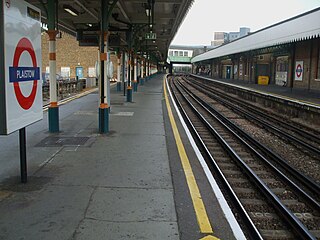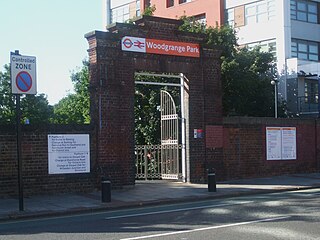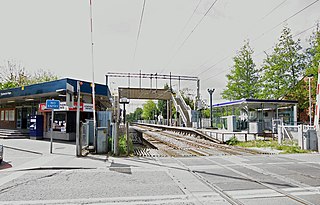
Trenitalia c2c trading as c2c is a British train operating company owned by Trenitalia that operates the Essex Thameside railway contract. It manages 25 stations and its trains call at 28. c2c provides commuter services from its London Fenchurch Street terminus to parts of East London and south Essex along the London, Tilbury and Southend line. At weekends it also operates from London Liverpool Street.

Limehouse is a National Rail and connected Docklands Light Railway (DLR) station in Limehouse, London, England. It is served by regional services operated by c2c to and from Fenchurch Street and by light metro services provided by the DLR to and from Tower Gateway or Bank. On the main line, Limehouse is located 1 mile 58 chains (2.8 km) from Fenchurch Street and the following station is West Ham; on the DLR it is between Shadwell and Westferry in Travelcard Zone 2.

Fenchurch Street railway station, also known as London Fenchurch Street, is a central London railway terminus in the southeastern corner of the City of London. It takes its name from its proximity to Fenchurch Street, a key thoroughfare in the City. The station and all trains are operated by c2c. Services run on lines built by the London and Blackwall Railway (L&BR) and the London, Tilbury and Southend Railway (LTSR) are to destinations in east London and south Essex, including Upminster, Grays, Basildon, Southend and Shoeburyness.

West Ham is a London Underground, Docklands Light Railway (DLR) and National Rail intermodal interchange station in West Ham, London, United Kingdom. The station is served by London Underground's District, Hammersmith & City and Jubilee lines, the Stratford International branch of the DLR, and c2c National Rail services.

Barking is an interchange station serving the town of Barking, east London. It is served by London Underground, London Overground and National Rail main line services. It is located on Station Parade, in the town centre.

Upminster is an interchange station serving the town of Upminster in the London Borough of Havering, Greater London. It is on the London, Tilbury and Southend line (LTSR), 15 miles 20 chains (24.5 km) down the line from London Fenchurch Street; it is the eastern terminus of the District line on the London Underground; and it is the eastern terminus of the Liberty line on the London Overground network. Upminster is the easternmost station on the London Underground network as well as the easternmost National Rail station in London.

The London, Tilbury and Southend line, also known as Essex Thameside, is a commuter railway line on the British railway system. It connects Fenchurch Street station, in central London, with destinations in east London and Essex, including Barking, Upminster, Basildon, Grays, Tilbury, Southend and Shoeburyness.

Plaistow is a London Underground station on Plaistow Road in the London Borough of Newham in Greater London. It is between West Ham and Upton Park stations on the District and Hammersmith & City lines, and in Travelcard Zone 3.

Becontree is a London Underground station located to the south of Becontree in the London Borough of Barking and Dagenham, east London. It is on the District line between Upney to the west and Dagenham Heathway to the east. It is 9.1 kilometres (5.7 mi) along the line from the eastern terminus at Upminster and 25.1 kilometres (15.6 mi) to Earl's Court in central London where the line divides into numerous branches. It is in London fare zone 5.

Woodgrange Park is a railway station on Romford Road in Manor Park in the London Borough of Newham, east London. It is served by the Suffragette line of the London Overground. It is located 12 miles 1 chain (19.3 km) down the line from Gospel Oak; it lies in Travelcard Zones 3 and 4. It has only limited station buildings and facilities.

The British Rail Class 357Electrostar is a class of alternating current (AC) electric multiple unit (EMU) passenger train built by Adtranz until 2001, later Bombardier, at Derby Litchurch Lane Works between 1999 and 2002. They were delivered in two batches at a cost of approximately £292 million.

Shoeburyness railway station is the eastern terminus of the London, Tilbury and Southend Line, serving the suburb of Shoeburyness, Essex. It is 39 miles 40 chains (63.57 km) down the main line from London Fenchurch Street via Basildon; the preceding station is Thorpe Bay. Its three-letter station code is SRY.

Southend Central railway station is on the London, Tilbury and Southend line and is one of two primary stations serving the city of Southend-on-Sea, Essex. The city's other main station is called Southend Victoria which is the terminus of a branch line off the Great Eastern Main Line. Southend Central is 35 miles 55 chains (57.43 km) down the line from London Fenchurch Street via Basildon and it is situated between Westcliff and Southend East stations. Its three-letter station code is SOC.

The Romford–Upminster line is a London Overground railway line in Greater London that connects Romford, on the Elizabeth line and Great Eastern Main Line, to Upminster, on the London, Tilbury and Southend line and London Underground. The route is 3 miles 28 chains (5.4 km) in length and there is one intermediate station at Emerson Park which is located 1 mile 62 chains (2.9 km) from Romford. The line is part of Network Rail Strategic Route 7, SRS 07.09, and is classified as a rural line.

Bow was a railway station in Bow, east London, that was opened in 1850 by the East & West India Docks and Birmingham Junction Railway, which was later renamed the North London Railway (NLR). The station was situated between Old Ford and South Bromley, and was located on the north side of Bow Road, close to the second Bow Road station which was open from 1892 to 1949. A covered footway connected the two stations between 1892 and 1917.

Leigh-on-Sea railway station is on the London, Tilbury and Southend line, serving the town of Leigh-on-Sea, Essex. It is 32 miles 43 chains (52.4 km) down the main line from London Fenchurch Street via Basildon and it is situated between Benfleet to the west and Chalkwell to the east. Its three-letter station code is LES.

Stanford-le-Hope railway station is on a loop line of the London, Tilbury and Southend line, serving the town of Stanford-le-Hope, Essex. It is 27 miles 13 chains (43.7 km) down the line from London Fenchurch Street via Rainham and it is situated between East Tilbury and Pitsea. Its three-letter station code is SFO.

Southend East railway station is on the London, Tilbury and Southend line, serving the Southchurch area to the east of Southend-on-Sea, Essex. It is 36 miles 49 chains (58.9 km) down the main line from London Fenchurch Street via Basildon and it is situated between Southend Central to the west and Thorpe Bay to the east. Its three-letter station code is SOE.
The London, Tilbury and Southend Railway (LT&SR), was a British railway company, whose network connected Fenchurch Street station, in central London, with destinations in east London and Essex, including Barking, Upminster, Grays, Tilbury, Southend and Shoeburyness. The company and its assets were sold to the Midland Railway in 1912. The network over which they operated is largely intact and is currently operated as part of the Essex Thameside franchise.

Shoeburyness Carriage Servicing Depot is an Electric Traction Depot located in Shoeburyness, Essex, England. The depot is situated on the London, Tilbury and Southend line and is near Shoeburyness station. To the east of the depot is MoD Shoeburyness and there is a rail connection into that site from the depot.



















